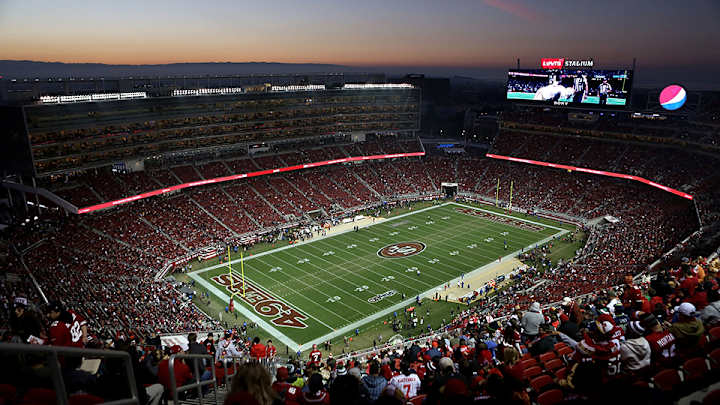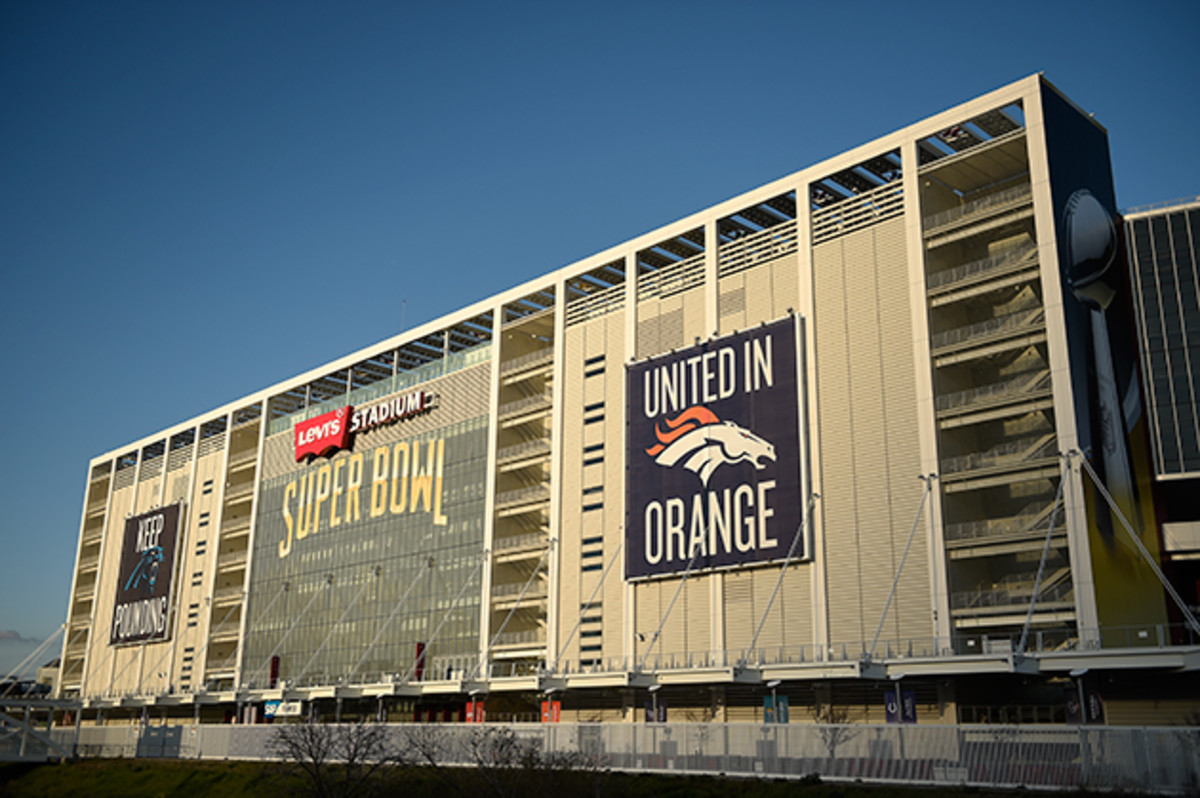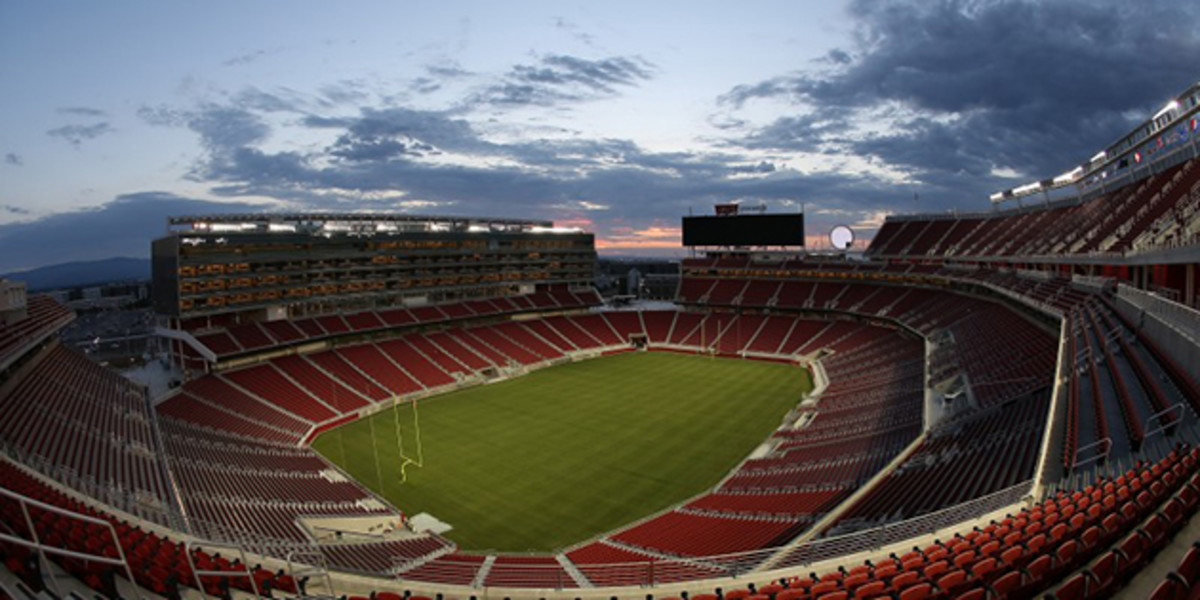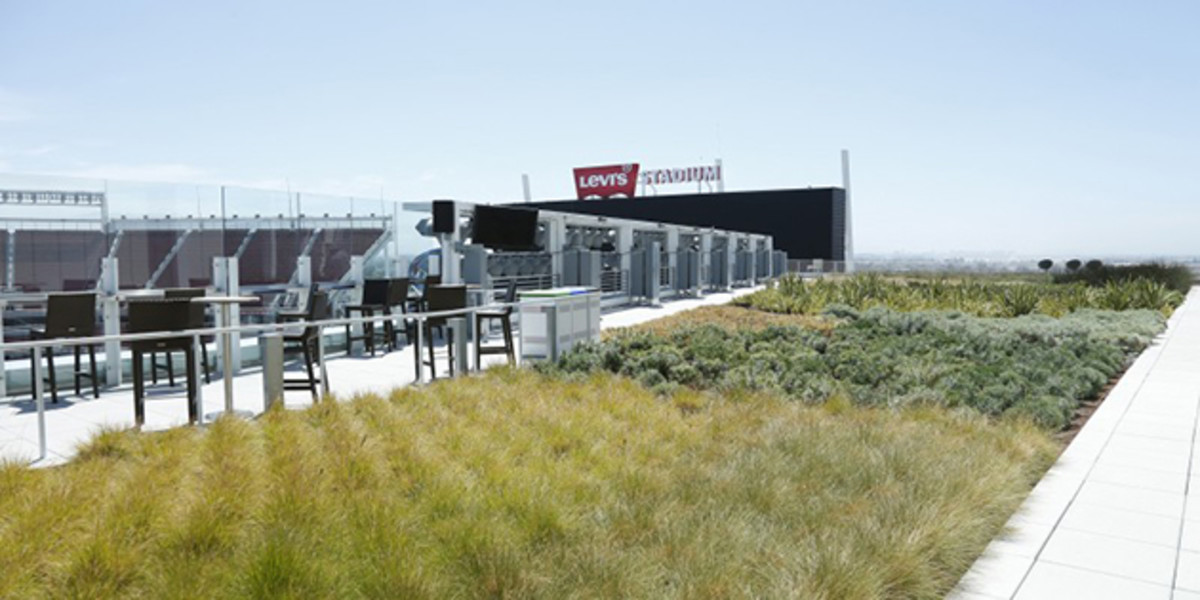Host to Super Bowl 50, Levi's Stadium is the sustainable arena of the future

Sustainability probably isn’t the most exciting subject in front offices around the NFL. But with big-money savings and positive effects on the fan experience, designing a sports sanctuary with longevity and environmental impact in mind is becoming the standard. With modern features like complex LED lighting, solar panels, concentrated-use energy systems and green roofs team executives can save their franchises millions. Fittingly, the NFL's marquee event, this year's Super Bowl between the Carolina Panthers and Denver Broncos, will be held in one of those monuments to forward-thinking innovation—Levi’s Stadium, the home of the San Francisco 49ers in Santa Clara, Calif.
“It was a vision of ours to be sustainable,” Al Guido, San Francisco 49ers’ chief operating officer, tells SI.com. “We wanted to be functionally green. We wanted to impact the day-to-day operations.”
Jim Mercurio, 49ers vice president in charge of stadium operations, tells SI.com the sustainability mandate came straight from the York family and at no point were they interested in what he terms simply a "greenwash."
“We actually believe in making a difference and if we can do it in this small park here, maybe we can inspire others, whether for stadiums or in everyday life,” Mercurio says.
The All-22: Four matchups that could determine who wins Super Bowl 50
This sustainable effort has helped propel Levi’s Stadium, open now since the summer of 2014, into LEED Gold status (the second-highest level of recognition issued by Leadership in Energy and Environmental Design, an internationally recognized green building certification system). And as the 49ers prepare to host the Super Bowl—with the world watching—they want to use the platform to share details of their effort and the benefits for fans.
Sustainability starts with design, first and foremost. At Levi’s Stadium, which was designed in part by the architecture firm of HNTB, the suite tower and the majority of premium space is all configured in a hub on one side of the stadium. Not only does that design create an efficient use of energy, Guido says, but it also fosters efficient operations. “It had to start with site selection, then the design of the building and then,” he says, “the third part is how do we make them operational.”
For LEED certification, the scorecards include decisions made when building—such as the 49ers’ embrace of local public transit, use of recycled materials from the old Moffett Field and sourcing of material locally—and then there’s the operational side of in-stadium recycling: water usage and energy reduction.
“When you look at the materials, waste management policy, water efficiency, purchasing policy, recycling methods [involved],” Mercurio says. “We have a recycle system that is really one of the first at this scale.”
The team uses systems designed to intentionally grab the water running off all areas of the building and use it in watering the landscape, the field and for bathroom facilities. And with artificial turf on the apron areas outside the playing surface of the field, those water needs have diminished in that area by nearly 30%.

When addressing water, the 49ers also wanted to reduce usage during the cleaning of the building. Instead of spreading one-inch hoses around the building to saturate the facility in water, they invested in power-washing tools for more pressure and less water. “It is decisions like that that are viewed as efficient and smart and not wasteful,” Mercurio says.
On the energy side, the team switched to LED lighting for all areas during the construction of the stadium, a major cost savings. “LED technology is becoming very prevalent in sports stadiums and the technology and price point evolved to make it worthwhile,” David Cooper, president of WSP | Parsons Brinckerhoff, the engineering firm behind the design of Levi’s Stadium, tells SI.com. “It is a combination of [sustainable] desire and economic pragmatism.”
Tech Talk: NFL quarterback sets out to reinvent hand warmers with startup
Then there are the small details that result in significant energy savings, such as clustering premium seating together, paperless ticketing, waste-flow efficiency and planting a garden atop the suite tower to reduce energy escaping from the building. The 49ers came up with a tailgating kit that offers bags to each tailgater, one for compost items, such as food waste, another for recycling and another for trash.
“What we asked people, is if you aren’t going to walk the distance to where we’ve placed these bins, put it in those bags,” Mercurio says. Sure, it cost more for the 49ers, but they saw it as part of an education as well. And while there’s always room for learning to be more environmentally friendly, he says, it is almost comical to see how far along folks have come. “Twenty years ago if [trash] even made it into the container that was one thing,” Mercurio says. Now they separate. “Fans are sophisticated and looking to educate.”
In all, 64% of consumer waste at Levi’s is recycled and 87% of durable goods get recycled, both much higher than average, even for the surrounding region. “While we’re happy that our current level of waste diversion is above the acceptable standards,” Mercuio says, “we are continuing to work hard to raise those percentages as high as possible.”
Guido says the 49ers have talked to executives throughout the NFL trying to spread the word of sustainability. That group includes Arthur Blank, the owner of the Falcons, and Rich McKay, the Falcons president, as well as Mark Wilf, Vikings owner, and Kevin Warren, chief operating officer of the Vikings.

The 49ers did the same thing when it was their turn, gaining wisdom from the sustainable work at Seattle’s CenturyLink Field and Philadelphia’s Lincoln Financial Field. “The NFL is doing a really nice job,” Guido says. “All these buildings are thinking about it. I’m really excited for what Atlanta and Minnesota [are doing]. I can’t speak for everyone, but for us it is about doing the right thing. You have to make a decision that you believe in the long-term.”
“Sustainability is definitely gaining strength, gaining steam,” Cooper says. “We are seeing it across multiple sectors, sports as well, as an attractive point, a selling point.” Cooper's firm helped the 49ers in upping the benchmark in the NFL with creative concepts like reclaiming water for multiple uses, solar panel installations that collect enough energy to power the stadium for all 10 home games and a 27,000-square-foot green roof on top of the suite tower.
Scott Jenkins, general manager of the Falcons’ new Mercedes-Benz Stadium, tells SI.com that sustainability is “definitely part of the design intent” for the new stadium set to open in 2017. The Falcons want to reach LEED Platinum (the highest level). “To get to platinum it has to be intentional,” he says. “To reach that high, it can’t be an after thought. Every decision, if it has an impact on efforts toward LEED, we stop and think.”
The left-handed logic of New York Giants wideout Odell Beckham Jr.
Designing differently takes effort, though. Jenkins, who also serves as the chair of the board for the Green Sports Alliance, says the easy thing to do is “mail in the design” and simply do what code dictates and not build sustainable.
Chris DeVolder, sustainable design leader for the HOK sports group, the architectural firm designing Atlanta’s new stadium, tells SI.com that as football stadiums look for sustainability it is about consuming less, while staying in use more. “By using systems every day you get a better return,” he says. And as stadiums move closer into urban environments, the stadiums—and teams—serve as the “front porch to the city and from that regard sports has a platform unlike any other part of our culture.”
From locating transit nearby to reducing pollution to LED lighting—easily the best new return-on-investment trend in sports right now—renewable energy or waste-management systems, DeVolder says sports teams have become far more conscious about how they design, both for their own efficiency and as a way to educate the public.
He sees the rise of sustainability as a trend in the past five or six years, but one that has become more readily available with increased partnerships and decreased costs. For the Falcons, DeVolder sees such features as shaded parking covered by solar panels, efficient energy systems, bike valets and electric car-charging stations as great examples. Of course, the waterless urinals will help in the building’s 44% reduction in water usage versus the Georgia Dome.
A major effort in Atlanta will be the one-million-gallon storm vault to collect storm water and the 680,000-gallon cistern that can allow the Falcons to reuse the water on-site. The initiative also improves the local neighborhoods’ chronic flooding issues.

Jenkins says that all those decisions had to come early, during design. For example, the retractable-roof stadium is being built like an outdoor stadium that can close when needed. “When outside, we want to rely on natural ventilation so we have to design it to function like an outdoor building,” he says. “But we have to be able to heat and cool when closed.” To solve that issue, the Falcons will have walls that can open and close to keep the natural ventilation intact and will use efficient boilers and chillers, a process that should bring energy demand to 34% below that of a normal building of the same size, saving $1 million per year in energy costs.
“We have been really intentional and authentic in how we do sustainability initiatives,” Jenkins says.
As part of the modern complex roof structure, WSP | Parsons Brinckerhoff will also be designing a 360-degree scoreboard for the Falcons stadium, in addition to smart technology that will provide new, creative ways for the team to interact with fans and educate them on the stadium's environmental features.
While the Eagles get credit for starting the renewable energy effort in the NFL in a big way, Jenkins says the 49ers and Levi’s Stadium were the first to get LEED certified. Next year the Vikings’ new home will follow suit. Then the Falcons’. “I don’t think in our industry the people who own teams and build these buildings want to be the lowest common denominator, they want to differentiate themselves,” he says. “Who wants to spend $1 million more on utilities? You are building a building for 30 years and you can spend one million more a year if you just mail it in. I think it would be really hard not to [design sustainably moving forward].”
DeVolder says that as the NFL continues to move toward sustainable stadiums, we’ll see more integration into the urban community, even things like cohabitating energy systems when possible. “Thinking about projects on a bigger scale is what we are looking forward to in the future,” he says. “Especially for the NFL. It makes a lot of sense.”
Tim Newcomb covers stadiums, sneakers and technology for Sports Illustrated. Follow him on Twitter at @tdnewcomb.
